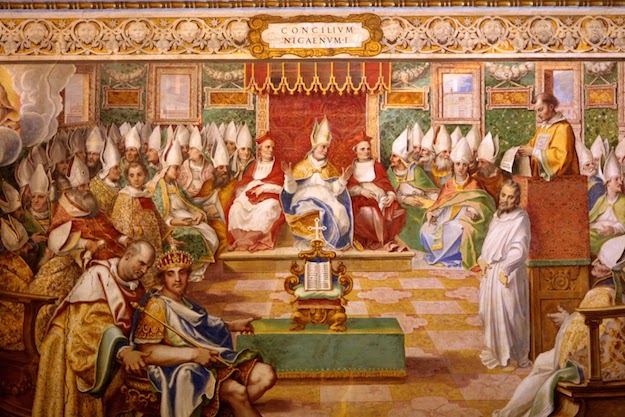“No other religion has so high an ideal of an inclusive community of love. Yet, as we are to see again and again…no other religion has had as many divisions and as many bitter controversies between its adherents. This contrast between dream and actuality was probably inevitable.” – Kenneth Scott Latourette, A History of Christianity
Church fights are nothing new. I have lived through them as a pastor. I have felt the tension, pressure, stress, and pain of Christians who cannot get along. If you have not suffered through a church fight, then I would presume you have at least have first-hand knowledge of one. We are called to love one another. No one would disagree with this fact. Jesus looked at his disciples, a diverse group of men including a former Jewish-sell-out and a former armed-Jewish-zealot, and commanded them to love each other to demonstrate to the world what it looks like to be his disciple. He even prayed for his followers, his church, to be one, even as he is one with his Father (John 17:11). This prayer for unity had barely left the lips of Jesus before his fledgling flock of disciples scattered after his arrest. Ideally we are to love one another deeply and authentically, in spite of our differences. In reality, we are often a fractured bunch allowing our discontinuities to drive a wedge into our unity. It has been so since the beginning.
The Apostolic church spread through the Mediterranean world meeting primarily in homes, gathering around the celebration of the resurrection of Jesus. The Gospels and letters from the Apostles were being circulated, but “belief in the Bible” was not what bound them together. It was a common faith and worship of Jesus held together by a common creed that emerged as a source of unity. Churches had their creeds, different versions of what we know as the Apostles’ Creed, but they did not have one unifying creed. Their unity faced opposition in the beginning as church leaders worked to break free from being viewed as a Jewish sect (the Judiazers). They stood firm against the secret knowledge of the Greek-minded dualists who denied the goodness of creation (Gnostics). In keeping with the teachings of the Apostles, they rejected the view that the God of Old Testament was an evil, lesser God than the God and Father of Jesus (Marcionites). They preserved the church from a hyper-mystical obsession with the imminent return of Christ (Montanists). They established the orthodox belief in one God distinctly revealed as Father, Son, and Holy Spirit against those who saw the persons of the Trinity as mere “modes” or expressions of God (Sabellianism). Each of these heretical groups created strife and division in the church.
The integrity of the unity of the church would face it biggest test in the third century. Christian voices from the city of Alexandria (i.e. Clement, Origen, Dionysius, and Athanasius) were consistently in harmony in their proclamation of the Trinitarian unity of God. The Father is God. The Son is God. The Spirit is God. The Father is not the Son. The Son is not the Spirit. The Spirit is not the Father. They were challenged from a voice from within with a new teaching reacting strongly to the false view of the Father, Son, and Spirit as modes of God. The voice was that of Arius, a preacher from Alexandria. His teaching was clear enough: “the Son has a beginning but that God is without beginning” (Latourette, 153). Arius was condemned by church leaders in Alexandria and exiled. The church’s teaching from the beginning was the Son is fully God. Athanasius, who became the most influential voice of orthodoxy against Arianism, argued God became man so man could become God. Man’s need for salvation did not come from the creation of a lesser god, but by God himself. If God in his full essence and being did not become man, salvation and union with God was not attainable. The supporters of Arius protested and the church was thrown into a terrible conflict. Arius found support chiefly from Eusebius, Bishop of Nicomedia, an adviser to the Emperor Constantine.
In light of the turmoil created by the Arian controversy in the Eastern portion of his empire, Constantine convened the first ecumenical council since the Council of Jerusalem recorded in Acts 15. Whether or not Constantine called for council for political or religious reasons may be a matter of conjecture, such is the case when the church reaches for Caesar’s sword. Nevertheless, 300 bishops from both the Western and Eastern parts of the church gathered in Nicaea in 325 AD to consider, among other things, how to move forward as a unified church in light of the now well-heated Arian controversy. Lay people from numerous churches also attended the council adding pressure to the already tense gathering. Those representing the Arian position presented their doctrine to a mixed reaction. The historian Eusebius of Caesarea offered a solution by calling on the council to adopt the creed used in Caesarea, a form of the Apostles’ Creed. His suggestion became the basis for what we now know as the Nicene Creed. The key Greek word added to the Nicene Creed to speak of Jesus was homoousius, meaning “one substance and essence.” According to the creed, Jesus was “very God of very God, begotten, not made, being of one substance with the Father.”
The decree of the council entirely failed to terminate the strife. Arianism continued to spread. After the death of Constantine in 337 AD Arianism was predominant in the Eastern churches. The council itself did not bring instant unity to the church, but the enduring value of the creed they adopted gave the church the symbol by which they found common ground as brothers and sisters in Christ. Arianism ultimately lost steam and the orthodox faith, captured in the Nicene Creed, emerged as the authentic faith of the Christian Church. The creed, born of controversy and division, became the “rule of faith” or “symbol of faith,” by which all Christians could join together in unity. It was further developed at the second ecumenical council in 381 AD and has carried on even in these modern times as a single connecting point where all Christians: Roman Catholic, Orthodox, and Protestants can join hands in Christian unity. Today we can find much to divide us in the body of Christ, my hope is we can find unity in our common belief in a common creed.
The creed has endured through previous conflicts, if we continue to allow it to form our faith, we can cling to the hope of real sincere unity in Christ.







Missio Alliance Comment Policy
The Missio Alliance Writing Collectives exist as a ministry of writing to resource theological practitioners for mission. From our Leading Voices to our regular Writing Team and those invited to publish with us as Community Voices, we are creating a space for thoughtful engagement of critical issues and questions facing the North American Church in God’s mission. This sort of thoughtful engagement is something that we seek to engender not only in our publishing, but in conversations that unfold as a result in the comment section of our articles.
Unfortunately, because of the relational distance introduced by online communication, “thoughtful engagement” and “comment sections” seldom go hand in hand. At the same time, censorship of comments by those who disagree with points made by authors, whose anger or limited perspective taints their words, or who simply feel the need to express their own opinion on a topic without any meaningful engagement with the article or comment in question can mask an important window into the true state of Christian discourse. As such, Missio Alliance sets forth the following suggestions for those who wish to engage in conversation around our writing:
1. Seek to understand the author’s intent.
If you disagree with something the an author said, consider framing your response as, “I hear you as saying _________. Am I understanding you correctly? If so, here’s why I disagree. _____________.
2. Seek to make your own voice heard.
We deeply desire and value the voice and perspective of our readers. However you may react to an article we publish or a fellow commenter, we encourage you to set forth that reaction is the most constructive way possible. Use your voice and perspective to move conversation forward rather than shut it down.
3. Share your story.
One of our favorite tenants is that “an enemy is someone whose story we haven’t heard.” Very often disagreements and rants are the result of people talking past rather than to one another. Everyone’s perspective is intimately bound up with their own stories – their contexts and experiences. We encourage you to couch your comments in whatever aspect of your own story might help others understand where you are coming from.
In view of those suggestions for shaping conversation on our site and in an effort to curate a hospitable space of open conversation, Missio Alliance may delete comments and/or ban users who show no regard for constructive engagement, especially those whose comments are easily construed as trolling, threatening, or abusive.